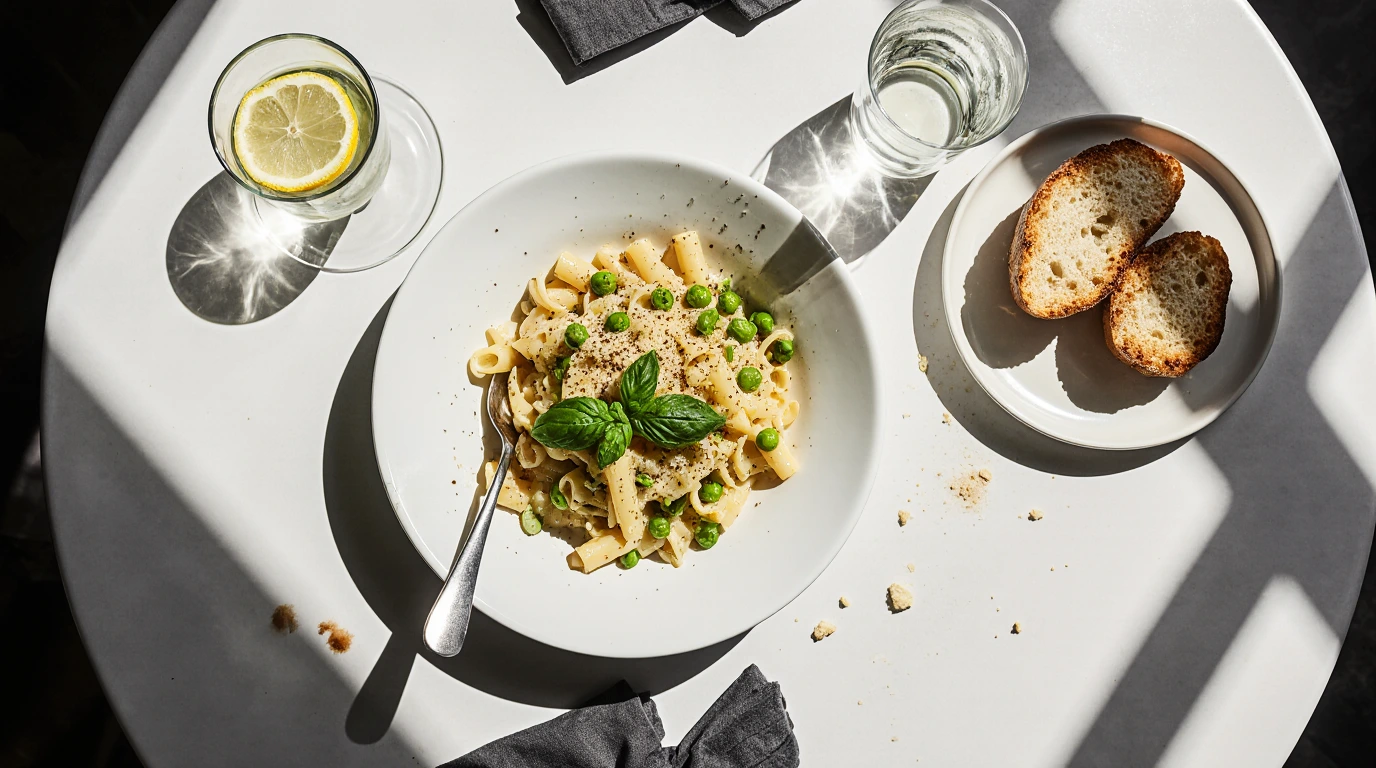You know those days when you’re not in the mood to cook—but still want something warm, filling, and familiar? That’s exactly when a dish like ditalini pasta with peas becomes more than just a meal—it becomes your comfort zone.
No elaborate preparation. No strange ingredients. Just you, a saucepan, and a few kitchen staples. And yet, the result feels rich, nurturing, and unexpectedly satisfying.
It could be the way ditalini turns tender as it absorbs the broth, or how the green peas bring a light, sweet taste to each spoonful. Maybe it’s the quiet rhythm of stirring something that smells like a childhood memory. Either way, you’ll notice something shifts—your body relaxes, your mind unwinds, and your kitchen feels a little more like home.
This isn’t about restaurant-style perfection or trendy presentation. It’s about real food made with intention. It’s about simple ingredients turning into a comforting bowl of warmth—fast, budget-friendly, and totally satisfying.
Whether you’re feeding yourself after a long workday or whipping up a quick dish your kids will actually eat, this recipe checks every box:
- Quick to make (under 30 minutes)
- Minimal cleanup (hello, one-pot!)
- Vegetarian-friendly and budget-wise
If you’ve never tried ditalini pasta before, get ready to meet a pantry hero that deserves a permanent place in your dinner rotation. And if you have tried it—well, you’re already smiling, because you know what’s coming.
Let’s get into it.
Table of Contents
What is Ditalini Pasta with Peas?
You might not recognize the name instantly, but once you try it, you’ll understand why this simple dish has stood the test of time. Ditalini pasta with peas—also known in Italian as pasta e piselli—is a humble yet flavorful one-pot recipe built on pantry staples. It blends tiny, tube-shaped ditalini pasta with sweet green peas in a light, savory broth, creating a dish that’s comforting, quick, and deeply satisfying.
What Makes Ditalini Special?
- Short, tube-like pasta that cooks quickly and absorbs flavor
- Spoon-friendly, making it ideal for brothy or creamy recipes
- Common in rustic, home-cooked Italian dishes
A Glimpse of Its Italian Roots
This recipe comes from Southern Italy, where families relied on affordable ingredients to create nourishing meals. No meat, no exotic spices—just a few simple items like pasta, peas, onions, and olive oil brought together with care. Over time, it became a comfort food staple, passed down through generations.
Why You’ll Keep Coming Back to It
- Quick prep and cooking time — You can make it fast, with everything ready in less than half an hour.
- Budget-friendly — uses ingredients you likely already have
- Customizable — add protein, herbs, or cheese if desired
- Comfort in every bite — warm, soft, and perfectly filling
Quick Reference Table
| Element | Details |
|---|---|
| Pasta Type | Ditalini (short, tube pasta) |
| Main Ingredients | Peas, onions, garlic, olive oil |
| Dietary Profile | Vegetarian-friendly |
| Texture | Creamy, broth-based |
| Origin | Southern Italy |
Ingredients You’ll Need for Ditalini Pasta with Peas
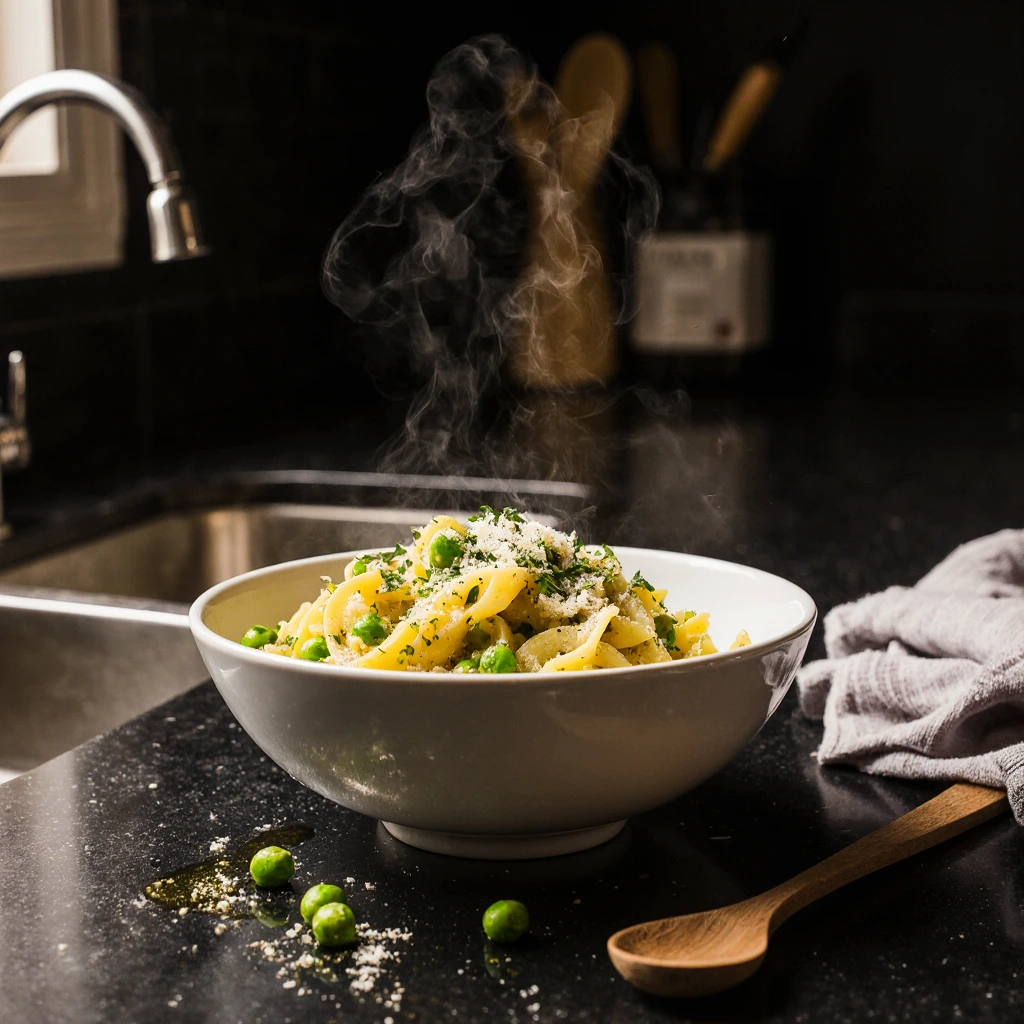
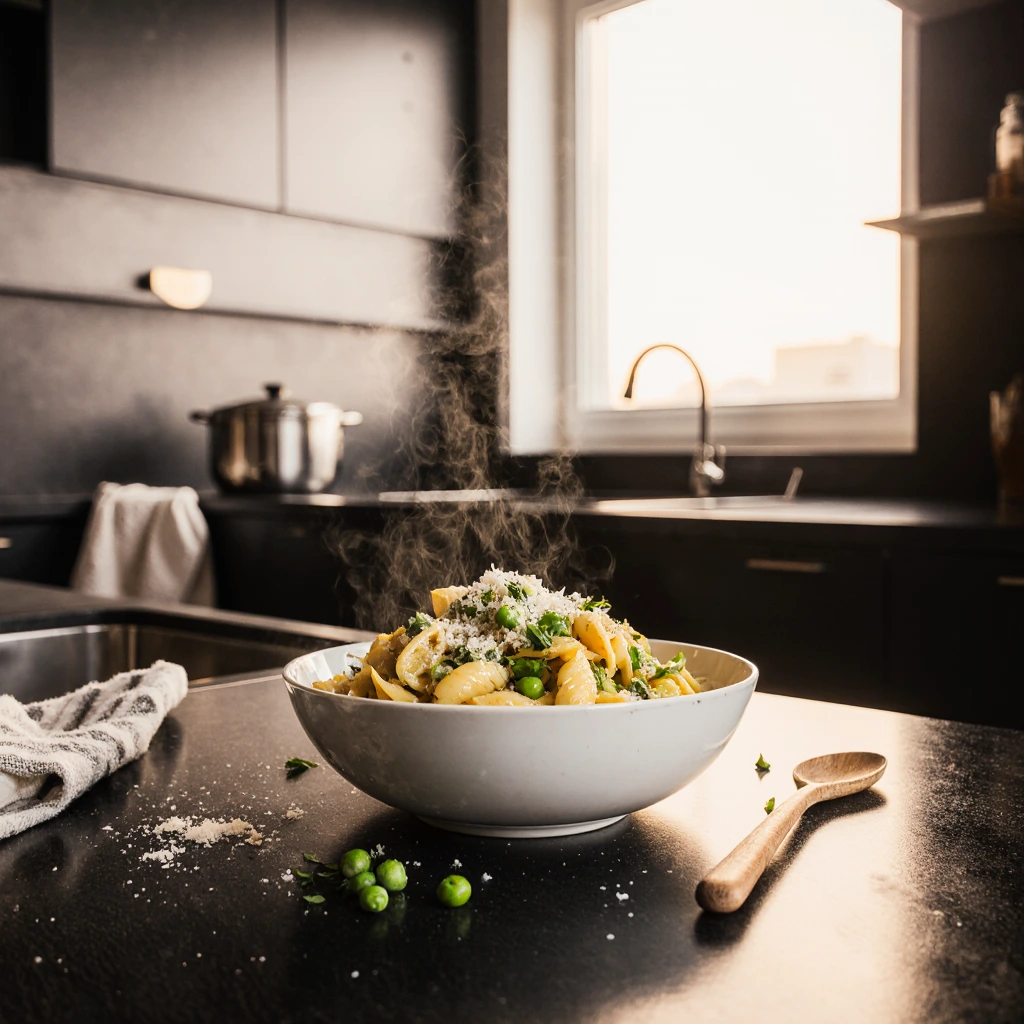
When you look at this dish, you might be surprised by how little it asks from you. Just a few everyday ingredients, many of which are probably already sitting in your pantry or freezer, come together to create something warm, flavorful, and deeply satisfying. That’s the beauty of ditalini pasta with peas—it doesn’t depend on complexity, it depends on balance.
What makes this meal shine is how each ingredient plays a role. You’re not just tossing things in a pot; you’re building a base of flavor, layering textures, and crafting something that feels thoughtful and homemade without the stress.
Your Ingredient Breakdown
| Ingredient | Amount | Role in the Dish |
|---|---|---|
| Ditalini pasta | 1 cup | Acts as the base, absorbs flavor and adds texture |
| Green peas (frozen) | 1 cup | Brings sweetness and soft contrast |
| Onion (chopped) | 1 medium | Forms the aromatic foundation |
| Garlic (minced) | 2 cloves | Adds depth and warmth |
| Olive oil | 2 tbsp | For sautéing and richness |
| Vegetable broth | 3 cups | Provides the body of the dish, keeps it moist and savory |
| Salt & black pepper | To taste | Enhances overall flavor |
| Parmesan cheese | ¼ cup | Optional, but boosts umami and creaminess |
Ingredient Notes You’ll Appreciate
- Ditalini Pasta: If you can’t find ditalini, feel free to use other small pastas like elbow macaroni or orzo. The key is something small enough to mingle with peas and soak in the broth.
- Frozen Peas: You don’t need anything fancy. Frozen peas are gathered when they’re perfectly ripe and work really well in this recipe.
- Broth Options: Vegetable broth keeps it vegetarian, but you can swap in chicken broth for a deeper flavor.
- Olive Oil: Don’t skip this. It carries the flavor from your aromatics into the broth.
- Cheese: Parmesan is a finishing touch. It’s optional, but a sprinkle right before serving brings out a wonderful salty richness.
Optional Add-Ins (If You Want to Make It Your Own)
Sometimes you want the classic version. Sometimes, you’re in the mood to try something different. Here are some additions you can try without disrupting the heart of the recipe:
- Red pepper flakes – For gentle heat
- Diced pancetta or bacon – Chopped pancetta or bacon adds a hint of smokiness to the dish.
- Shredded mozzarella – For a creamier bite
- Fresh parsley or basil – Chopped parsley or basil brings a fresh touch and a bit of color to the plate.
Cooking doesn’t have to be complicated to be memorable. By starting with ingredients you recognize and trust, you can create a dish that feels both effortless and impressive. Now that you’ve got your ingredients lined up, let’s move to the part where the magic happens—bringing it all together in one delicious pot.
Step-by-Step Instructions to Make Ditalini Pasta with Peas
Now that you’ve gathered your ingredients, it’s time to bring everything to life. Don’t worry—this recipe doesn’t demand expert skills or special tools. You won’t need to fuss over multiple pans or complicated timing. With just one pot and one spoon, you’ll be guiding familiar ingredients into a meal that feels hearty, flavorful, and soul-warming.
Each step in this process is about building flavor gradually, letting every component contribute to the final taste. You’ll notice how something as small as stirring at the right time or simmering just a bit longer can make the dish feel more intentional—more yours.
Cooking Instructions at a Glance
| Step | Action | Time | Notes |
|---|---|---|---|
| 1 | Sauté onion and garlic in olive oil | 3–4 mins | Build the aromatic base |
| 2 | Add peas and season | 2 mins | Stir gently to coat peas in flavor |
| 3 | Pour in broth and bring to boil | 2–3 mins | Helps soften peas and form the broth |
| 4 | Stir in ditalini pasta | 8–10 mins | Let it cook in the broth until tender |
| 5 | Adjust seasoning | 1 min | Add salt, pepper, and optional extras |
| 6 | Optional: Stir in parmesan cheese | 1 min | For added creaminess and depth |
| 7 | Serve hot | — | Garnish with herbs or extra cheese if desired |
Detailed Steps You’ll Actually Enjoy Doing
Step 1: Sauté the Aromatics
Start by heating olive oil over medium heat in a large pot or deep saucepan. Add chopped onions and let them cook until translucent, not browned. Mix in the minced garlic and let it cook for one more minute — the smell tells you something delicious is coming. the transformation—it’s the start of something good.
Step 2: Add the Peas
Toss in your frozen peas and stir them with the onions and garlic. This helps the peas soak up that base flavor instead of tasting like they came straight from the freezer. Cook just until they begin to get a little tender.
Step 3: Pour in the Broth
Pour in the veggie broth and let it slowly reach a soft boil. This is where the dish starts to shift from dry ingredients to something spoonable and comforting.
Step 4: Add the Ditalini
Drop the pasta right into the simmering broth and give it a stir. Don’t boil it separately—this is a one-pot dish for a reason. Let the pasta simmer, uncovered, for about 8 to 10 minutes, stirring occasionally. As it cooks, the pasta will soak up the broth and thicken the whole mixture naturally.
Step 5: Taste and Adjust
Give it a taste—does it need more salt? A little black pepper? Feeling adventurous? A small shake of red pepper flakes can add a nice kick. Adjust the seasoning to match your mood.
Step 6 (Optional): Add Parmesan
If you’re adding parmesan, now’s the moment. Mix it in just before serving to make the dish creamier and add a deeper flavor.
Step 7: Serve It Up
Spoon into bowls while it’s hot. Garnish with fresh herbs if you like—parsley or basil both work beautifully. And if you’re feeling extra, drizzle a little more olive oil on top or add a second sprinkle of cheese.
Extra Cooking Tips for Best Results
- Keep stirring after adding the pasta so it doesn’t stick together.
- Keep heat at medium to avoid overcooking the peas
- For a looser consistency, add a splash of hot water before serving
- Let it rest a few minutes before you serve — it gets thicker as it cools slightly.
With these steps, you’re not just following a recipe—you’re crafting a moment. One bowl, one spoon, and a warm kitchen that smells like home. Ready for the first bite? Next up, let’s explore some ways you can switch things up.
Why You’ll Love This Ditalini Pasta Recipe
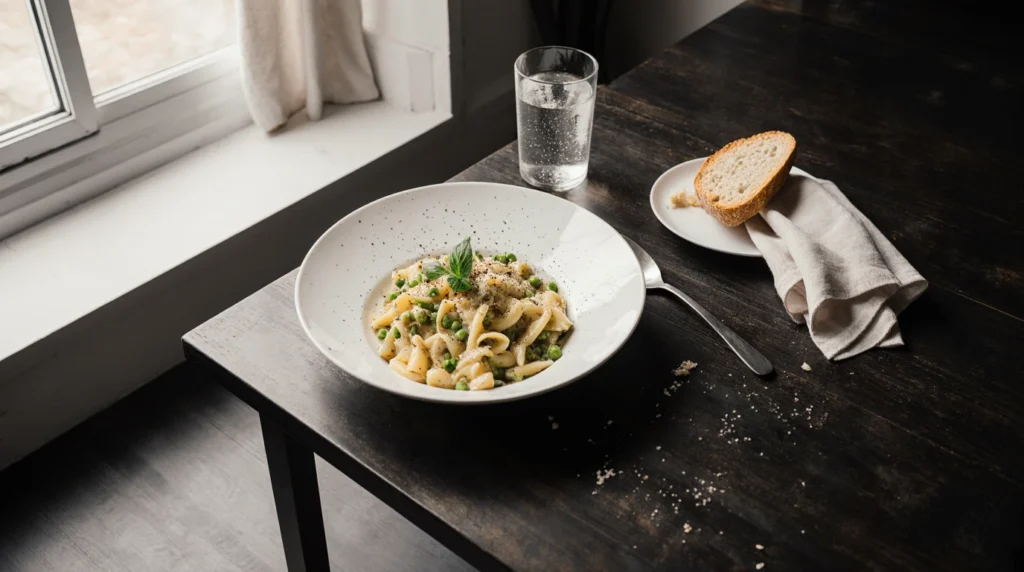
You know how some recipes just click with your lifestyle? That’s exactly what happens with this ditalini pasta with peas. It’s not one of those complicated meals that requires an hour of prep and a sink full of dishes. Instead, it’s a dish that respects your time, uses what you already have, and still tastes like something special. You get flavor, comfort, and ease—all in a single bowl.
This isn’t just another pasta recipe—it’s one that becomes part of your routine, the kind of meal you reach for when you want something quick, cozy, and consistently delicious. Whether you’re cooking for yourself, your kids, or just need a no-fuss dinner after work, this one has you covered.
Top Reasons This Recipe Works for You
| Benefit | Why It Matters to You |
|---|---|
| One-Pot Convenience | Fewer dishes, easier cleanup, less stress |
| Quick to Cook | Done in under 30 minutes—perfect for busy evenings |
| Budget-Conscious | Uses low-cost, pantry-friendly ingredients |
| Flexible & Customizable | Add herbs, spices, cheese, or protein—your choice |
| Vegetarian-Friendly | Meatless but still satisfying and flavorful |
| Family-Approved Flavor | Kids and adults both enjoy the creamy, mild taste |
Comfort Food Without the Guilt
You don’t need heavy cream or loads of cheese to make something comforting. You get a warm, creamy feel from this pasta without adding much—just the pasta’s starch and the gentle sweetness of peas do the trick. It’s filling without being overwhelming, making it a perfect meal for any season.
Perfect for Beginners and Experienced Cooks Alike
- If you’re new to cooking: This recipe teaches you essential techniques—like building flavor with aromatics and cooking pasta in broth.
- If you’re experienced: You’ll love how easily this adapts to your style. Try it with your own stock, add some pancetta, or brighten it up with herbs and a bit of lemon peel.
Everyday Ingredients, Elevated Taste
What’s special here isn’t just the flavor—it’s how much flavor you get from so little. A handful of simple ingredients can taste like something far more complex when treated right. And the best part? There’s no need to go out hunting for special ingredients — simple pantry items are enough.
When you combine all these elements—speed, simplicity, taste, and versatility—you end up with a pasta dish that feels like a go-to rather than a one-time experiment. You’ll make it once, enjoy every bite, and soon find yourself making it again without even glancing at the recipe.
That’s when you know a dish truly belongs in your kitchen.
Variations to Try
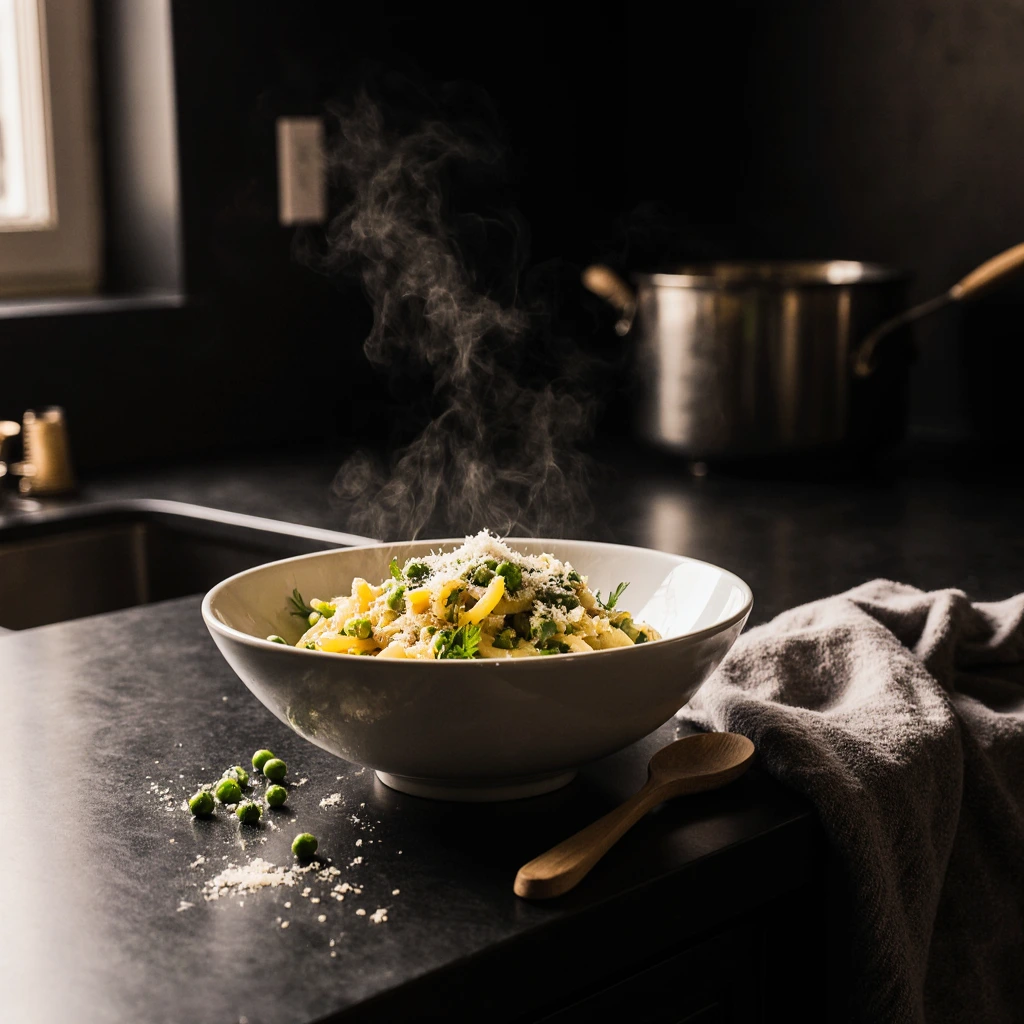
One of the best parts about ditalini pasta with peas is how effortlessly it adapts to your preferences, dietary needs, or just whatever’s left in your fridge. Once you’ve mastered the basic version, you’ll realize how open it is to interpretation. It’s like a canvas—you already have the base, and now it’s your turn to add a few strokes of creativity.
Whether you want to turn it into a heartier meal, sneak in more vegetables, or lean into bolder flavors, there’s a variation out there that’s going to suit your style. These aren’t complicated changes—just smart swaps or additions that keep the simplicity intact while tailoring the flavor to your mood.
Customize Your Ditalini Pasta with These Easy Ideas
Add Protein (Make It More Filling)
If you want something more substantial, these options add heartiness without overwhelming the balance:
- Grilled chicken strips – Mild enough to let the peas shine
- Crispy pancetta or bacon – Crunchy bits of pancetta or bacon bring a salty, smoky bite to the mix.
- Italian sausage – A flavorful upgrade with spice and depth
- Chickpeas or white beans – White beans or chickpeas are perfect if you want some plant-based protein.
Boost the Veggies (Add Color and Nutrition)
Your dish can go greener or more colorful without losing the original comfort vibe:
- Spinach or kale – Stir in at the end to wilt gently
- Diced zucchini or carrots – Add chopped zucchini or carrots when cooking the onion to give it more texture.”
- Cherry tomatoes – Add brightness and a pop of acidity
Switch Up the Cheese (Play with Flavor)
Parmesan works great, but why stop there?
- Pecorino Romano – A sharper, saltier cheese for a bolder finish
- Ricotta dollops – For a creamy, melt-in-mouth experience
- Mozzarella cubes – Stir in while warm to get that cheesy stretch
Experiment with Herbs and Spices (Layer the Flavor)
Small adjustments here can shift the flavor profile dramatically:
- Basil or parsley – Fresh and aromatic
- Red pepper flakes – Adds gentle heat without overpowering
- Lemon zest – For brightness and contrast to the sweetness of peas
- Italian seasoning – A quick way to infuse more herb flavor
Dietary Variations Worth Considering
| Dietary Need | Simple Variation to Use |
|---|---|
| Gluten-free | Use gluten-free ditalini or short pasta |
| Vegan | Skip cheese or use nutritional yeast instead |
| Low-sodium | Use low-sodium broth and limit added salt |
| Dairy-free | Omit cheese or use a dairy-free alternative |
You really can’t go wrong when adding your personal touch to this dish.” You’ve got a flexible foundation that responds well to your preferences—so don’t hesitate to experiment. Whether you’re cooking for picky eaters, looking to add leftovers, or just curious to try something new, these variations will help you reinvent the same dish over and over again—without it ever getting old.
Storage & Reheating Tips
Once you’ve enjoyed a warm bowl of ditalini pasta with peas, you might be wondering what to do with the leftovers. The good news? This dish holds up well in the fridge and tastes just as comforting the next day—sometimes even better, as the flavors continue to blend. With a few smart storage and reheating techniques, you can keep that just-cooked texture and taste without sacrificing quality.
By learning how to properly store and reheat this simple pasta recipe, you’re saving time, reducing waste, and ensuring a quick meal is always within reach.
How to Store Leftover Ditalini Pasta with Peas
Whether you’re storing extra portions for lunch or meal-prepping for the week, here’s how to keep everything fresh:
In the Fridge
- Cool it first: Let your pasta come to room temperature before storing.
- Use an airtight container: Keeps moisture locked in and fridge smells out.
- Best within 3–4 days: For peak flavor and food safety.
In the Freezer
- Freeze only if needed: The texture of the peas and pasta may soften after thawing, but it’s still tasty.
- Portion it out: Use freezer-safe containers or zip bags to portion meals individually.
- Label with date: Helps track freshness—consume within 1 month for best results.
Best Reheating Methods to Preserve Texture & Flavor
On the Stovetop (Recommended)
This method gives you the most control over texture and avoids mushy pasta.
- Pour in a little water or veggie broth if the pasta feels too thick.
- Reheat on medium, stirring now and then until it’s warmed through.
- Optional: Sprinkle a bit of parmesan or drizzle olive oil to refresh the flavor.
In the Microwave (Quick Fix)
Perfect for a work lunch or when you’re short on time.
- Put the pasta in a microwave-safe bowl and add a bit of water or broth.
- Cover it lightly with a lid or a damp paper towel to keep moisture in.
- Use medium power and heat in 30-second rounds, giving it a stir each time to warm it evenly.
From Frozen
- Thaw overnight in the fridge before reheating, or
- Reheat straight from frozen on the stovetop with added liquid—just increase cook time and stir often.
Tips to Keep the Pasta Tasting Fresh
- Avoid overcooking when reheating: Too much heat for too long will make the pasta too soft.
- Don’t skip the liquid: A bit of moisture is key to reviving the sauce-like texture.
- Freshen with herbs or lemon zest: A quick sprinkle wakes up the flavor instantly.
Storing and reheating ditalini pasta with peas doesn’t have to be a compromise. With the right approach, you can enjoy its warmth and simplicity even days after you first made it—perfect for busy nights, work lunches, or whenever you need a no-stress meal that still feels home-cooked.
Ditalini Pasta with Peas Nutrition Facts
Understanding what goes into your bowl matters—especially when you’re aiming to eat more mindfully without giving up comfort and flavor. With ditalini pasta with peas, you’re not only getting a satisfying, easy-to-make meal but also a balanced dish that provides essential nutrients to fuel your day. It’s a recipe that nourishes your body just as much as it comforts your soul.
This dish may look simple, but it actually packs a decent nutritional punch. Whether you’re watching your carbs, looking for fiber, or trying to get more plant-based protein, this classic combo of pasta and peas has you covered in more ways than one.
A Quick Breakdown of Key Nutrients (Per 1 Serving)
| Nutrient | Estimated Amount | Why It Matters to You |
|---|---|---|
| Calories | ~320 kcal | Keeps you energized without feeling heavy |
| Protein | ~10–12 g | Supports muscle repair and keeps you full longer |
| Carbohydrates | ~50–55 g | Provides sustained energy |
| Dietary Fiber | ~6–8 g | Supports digestion and helps control appetite |
| Fat | ~6–8 g | Comes mainly from olive oil and optional cheese |
| Saturated Fat | ~2–3 g | Moderate levels if cheese is added |
| Sodium | ~400–500 mg | Varies depending on broth and seasoning used |
| Vitamin C | ~10–15% DV | Supports immunity, especially from peas |
| Iron | ~10% DV | Helps maintain healthy red blood cells |
| Calcium | ~8–10% DV | Boosted by the cheese if added |
What Makes It a Balanced Meal?
You might be surprised by how naturally this recipe balances macros and micros:
- Carbs from ditalini: A quick energy source that’s ideal for lunch or dinner
- Plant-based protein from peas: Helps build and repair tissue—great for vegetarians
- Fiber from both pasta and peas: Keeps your digestion on track and helps you feel full
- Healthy fats: If you use olive oil or cheese, you get a dose of good fats that aid nutrient absorption
Make It Even Healthier (Optional Upgrades)
You can easily boost the nutritional profile of your ditalini pasta with a few smart choices:
- Swap to whole wheat pasta for added fiber and minerals
- Use low-sodium broth to reduce overall salt content
- Add leafy greens like spinach for more vitamins and antioxidants
- Toss in beans or lentils for additional plant-based protein and iron
- Top with nutritional yeast instead of cheese for a dairy-free B12 source
Even comfort food can be wholesome when built on simple, nutritious ingredients—and ditalini pasta with peas is proof of that. Whether you’re planning meals for the family or just making something cozy for yourself, it’s nice to know your go-to recipe is doing more than just tasting good—it’s helping you feel good too.
Frequently Asked Questions (FAQs)
When trying a new dish like ditalini pasta with peas, it’s natural for a few questions to come up. Whether you’re wondering about substitutions, how to keep the texture just right, or how to adapt the recipe for dietary needs, having clear answers can make the experience smoother. These quick answers are here to guide you so you can cook this cozy, flexible meal with ease.
Can I use frozen peas instead of fresh?
Absolutely. You’ll find that frozen peas are just as nutritious and often more convenient. Just add them in during the last few minutes of cooking—they’ll thaw quickly and maintain their bright color and sweet flavor.
What can I use instead of ditalini pasta?
If you don’t have ditalini on hand, don’t worry. Any small pasta shape works well, especially ones that hold sauce or broth nicely:
- Elbow macaroni
- Small shells
- Orzo
- Tubetti or pastina
Just remember to tweak the cook time depending on the type of pasta you use.
How can I make this recipe gluten-free?
To make a gluten-free version:
- Swap regular ditalini for gluten-free pasta made from rice, corn, or chickpeas.
- Double-check your broth and seasonings to ensure they don’t contain hidden gluten.
This keeps the dish friendly for those with gluten sensitivity or celiac.
Is it possible to prepare ditalini pasta with peas in advance?
Yes, this dish is ideal for meal prep. Here’s how:
- Cook and cool the pasta fully.
- Store in an airtight container for up to 3–4 days in the fridge.
- Reheat gently with a splash of broth or water to bring back the creamy texture.
It’s perfect for work lunches or fast weeknight dinners.
Is this recipe suitable for kids?
Definitely. The soft pasta, sweet peas, and mild flavors make it very child-friendly. If you’re cooking for picky eaters, try:
- Mashing the peas slightly for smoother texture
- Adding a sprinkle of shredded cheese on top
- Serving with breadsticks or a fun side dish to make it more appealing
Can I add meat or make it vegetarian/vegan?
This recipe is highly adaptable:
- Add meat like pancetta, ground chicken, or sausage if desired.
- Make it vegetarian by using vegetable broth and omitting meat.
- Go vegan by skipping cheese and using olive oil or nutritional yeast for flavor.
You can truly make it your own, no matter your diet.
Having these questions answered ahead of time takes the guesswork out of the kitchen. Whether you’re cooking it for the first time or planning to make it part of your regular dinner rotation, knowing what to expect helps you feel in control and creative. That’s the beauty of cooking something as flexible and satisfying as ditalini pasta with peas.
Conclusion
You’ve now got everything you need to make ditalini pasta with peas not just another meal, but a go-to comfort dish in your kitchen. It’s proof that simplicity can be incredibly satisfying when you know how to bring flavors together the right way. With only a handful of ingredients and a short prep time, you can turn an ordinary evening into something warm, wholesome, and full of flavor—without relying on complicated techniques or hard-to-find items.
What really sets this recipe apart is how easy it is to adapt to your taste. Whether you’re cooking for one, feeding a family, or prepping for the week ahead, it adapts to your needs without losing its charm. You can customize it to your dietary preferences, sneak in extra veggies, or keep it classic. Either way, it’s a dish that brings people to the table.
So next time you’re craving a quick and nourishing meal, remember what you’ve learned here. Your version of ditalini pasta with peas can be as simple or as inventive as you like—and the best part is, you’re fully in control of every step.
